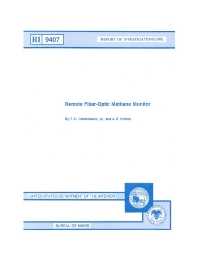Mining Publication: Remote Fiber-Optic Methane Monitor
Original creation date: January 1992
Fiber-optic technology is progressing rapidly, including the development of fiber-optic sensors for many applications. These sensors have the advantages of high sensitivity, light weight, small size, high bandwidth, and freedom from electromagnetic influences. The U.S. Bureau of Mines is investigating the use of fiber-optic technology to monitor mine atmospheres. This report describes a methane monitor based on differential absorption of infrared light. The monitor can detect methane concentrations as low as 0.2 Vol pct as far away as 2 km via fiber-optic cable. The upper range is 100 vol pct methane. Since the system requires no electrical power within the mine, it is intrinsically safe.
Authors: TH Dubaniewicz, JE Chilton
Report of Investigations - January 1992
NIOSHTIC2 Number: 10011221
Pittsburgh, PA: U.S. Department of the Interior, Bureau of Mines, RI 9407, 1992 Jan; :1-8
See Also
- Adapting Remote Methane Leak Detector (RMLD) to Coal Miner Rescue
- Evaluating Performance Characteristics of Machine-Mounted Methane Monitors by Measuring Response Time
- Evaluation of Person-Wearable Methane Monitors
- Factors Affecting the Location of Methanometers on Mining Equipment
- Ignition of Methane-Air Mixtures by Laser Heated Small Particles
- Lasers
- Methane Detection and Monitoring
- Methane Emission Rate Studies in a Northern West Virginia Mine
- Methane-Air Mixtures Ignited by CW Laser-Heated Targets on Optical Fiber Tips: Comparison of Targets, Optical Fibers, and Ignition Delays
- Remote Methane Sensors
- Use of a Test Box to Measure Response Times for Machine-Mounted Monitors
- Content source: National Institute for Occupational Safety and Health, Mining Program


 ShareCompartir
ShareCompartir
